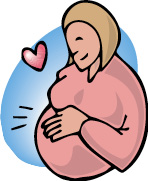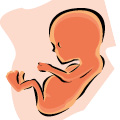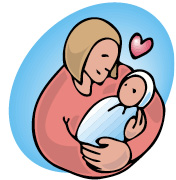

 The conception, development, and birth of a child is a
natural thing. We see it in one way or another on virtually a daily
basis. We may recognize that the whole process is incredibly complex,
but the number of babies born every day in the world makes us recognize
that the system works pretty well, even though we are made painfully
aware that things can go wrong.
The conception, development, and birth of a child is a
natural thing. We see it in one way or another on virtually a daily
basis. We may recognize that the whole process is incredibly complex,
but the number of babies born every day in the world makes us recognize
that the system works pretty well, even though we are made painfully
aware that things can go wrong.
The fact is that a baby has genetic material from both parents and thus is an entity of its own. Contrary to the thinking of abortionists, the baby is not an extension of its mother's body. That means that the immune system of the mother will treat the baby like any other foreign body and will attempt to destroy it. Why did not your mother's immune system destroy you? Immunologists have struggled with this question for more than fifty years. In our age of organ transplants this question has resurfaced with great interest since rejection is the single biggest threat in organ transplants. Dr. Peter Medawar has been the leading authority on this question having posed what is now called the "immunological paradox of pregnancy."
When the sperm fertilizes the egg it rapidly divides to form the blastocyst, a hollow ball of cells with an inner cell mass and an outer layer. The inner cell mass gives rise to the embryo, which develops into a fetus about eight weeks after conception. By this time all of the organs of the baby are recognizable. The outer layer of the blastocyst becomes the trophoblast. The trophoblast invades the lining of the uterus beginning the process of implantation. The trophoblast transforms into the fetal part of the placenta that brings nutrients and oxygen from the mother to the baby. During this process some of the mother's cells form a part of the mature placenta. The mystery that science still has not resolved is why the mother's immune system tolerates all of this, especially the trophoblast cells.
 Our immune system eliminates invaders in two ways. The
first is called "innate immune response" in which the body neutralizes
invaders before they can cause harm. When you cut yourself, white blood
cells called macrophages engulf the bacterial invaders and eliminate
them through a complex system. The second method called "acquired
immunity" relies on antibodies and specialized white blood cells called
B cells
and T
cells. These cells target particular foreign material to which the body
has already been exposed. This system "remembers" encounters with
specific invaders and reacts quickly and vigorously to further
exposure. The fetus is certainly an invader, and the mother's body does
respond with an innate immune response during the first twelve weeks of
pregnancy resulting in "morning sickness." So why does this not
continue and destroy the baby?
Our immune system eliminates invaders in two ways. The
first is called "innate immune response" in which the body neutralizes
invaders before they can cause harm. When you cut yourself, white blood
cells called macrophages engulf the bacterial invaders and eliminate
them through a complex system. The second method called "acquired
immunity" relies on antibodies and specialized white blood cells called
B cells
and T
cells. These cells target particular foreign material to which the body
has already been exposed. This system "remembers" encounters with
specific invaders and reacts quickly and vigorously to further
exposure. The fetus is certainly an invader, and the mother's body does
respond with an innate immune response during the first twelve weeks of
pregnancy resulting in "morning sickness." So why does this not
continue and destroy the baby?
Every proposal that has been given by scientists over the years has failed. One proposal was that the trophoblast forms a mechanical barrier that stops the immune system. Studies have shown that no such barrier exists. In fact, fetal cells are found in the mother's body decades after pregnancy. In 2002 researchers at Tufts University demonstrated that fetal cells help the mother in repairing her damaged tissues. In one case a woman who had hepatitis regenerated liver cells when her body could not. It turned out that the new liver cells came from fetal cells. The baby had repaid the mother for her dedication to the baby. Clearly there is no barrier. Some have proposed that the mother's immune system is suppressed during pregnancy. But if that were the case pregnant women would be prone to every illness in the book--especially women with HIV who would quickly die of AIDS.
 The most recent understanding of this complex question is
that the trophoblast and the mother's immune system join forces to
fight common enemies. Apparently the mother's immune system recognizes
her own offspring so that when the trophoblast cells have an attack by
infectious microorganisms they send out a chemical signal that
activates the mother's immune system and they work together to protect
the baby. We have simplified this explanation a great deal. Those
interested in a more complete treatment of the mechanics of this
process can read Gil Mor's excellent explanation in Natural History magazine, May 2007,
page 36.
The most recent understanding of this complex question is
that the trophoblast and the mother's immune system join forces to
fight common enemies. Apparently the mother's immune system recognizes
her own offspring so that when the trophoblast cells have an attack by
infectious microorganisms they send out a chemical signal that
activates the mother's immune system and they work together to protect
the baby. We have simplified this explanation a great deal. Those
interested in a more complete treatment of the mechanics of this
process can read Gil Mor's excellent explanation in Natural History magazine, May 2007,
page 36.
The importance of understanding this complex system should be obvious from a medical standpoint. Birth defects, problems that occur during pregnancy, ways of using the immune system to more effectively treat disease, and a variety of other conception issues can be benefited when we understand more fully how this system works. There are many other important issues that can be better understood when we comprehend how exquisitely designed and synchronized this system is.
Attempting to maintain that this is a chance-produced mechanism
takes a high level of imagination. Reproduction is a vital part of
life, and in higher forms of life the reproductive system is so
incredibly complex that the best minds of science are still grappling
with it. It should also be obvious that abortion flies in the face of
this design. How can we in good conscience do violence to this system?
It is clear that the baby is not an extension of the mother's body, and
that the design of the system is to protect the baby in a highly
sophisticated way. No body system can block an external intelligence
coming in with sharp instruments and cutting the fetus into small
pieces and flushing it out of the  womb, but imagine the chaos that must result in the
immune system when such a brutal act is done. Abortion needs to be
reclassified as infanticide, and put into the brutal acts of history as
an example of what happens when selfishness and brutality rule a
civilization.
womb, but imagine the chaos that must result in the
immune system when such a brutal act is done. Abortion needs to be
reclassified as infanticide, and put into the brutal acts of history as
an example of what happens when selfishness and brutality rule a
civilization.
That having been said, it is important to understand that unwanted pregnancies force the mother to have her immune system engaged in accepting something she does not want. It is vital that the behaviors that lead to unwanted pregnancy be addressed in a better way. It is also vital that babies who are unwanted by the biological mother be given a chance to be adopted by a mother who desperately wants to raise that child and love it in the most complete way. We are not mindless robots driven by chemicals and passion. God gives us the ability to choose what we will do, and to seek kind and loving solutions when problems do arise.
People say it is a matter of "choice." Really it is about whether we will make destructive choices that do violence to the design built into us by the Creator or whether we will make choices that bless others and provide kind and loving solutions even for difficult situations.
Back to Contents Does God Exist?, JanFeb09.